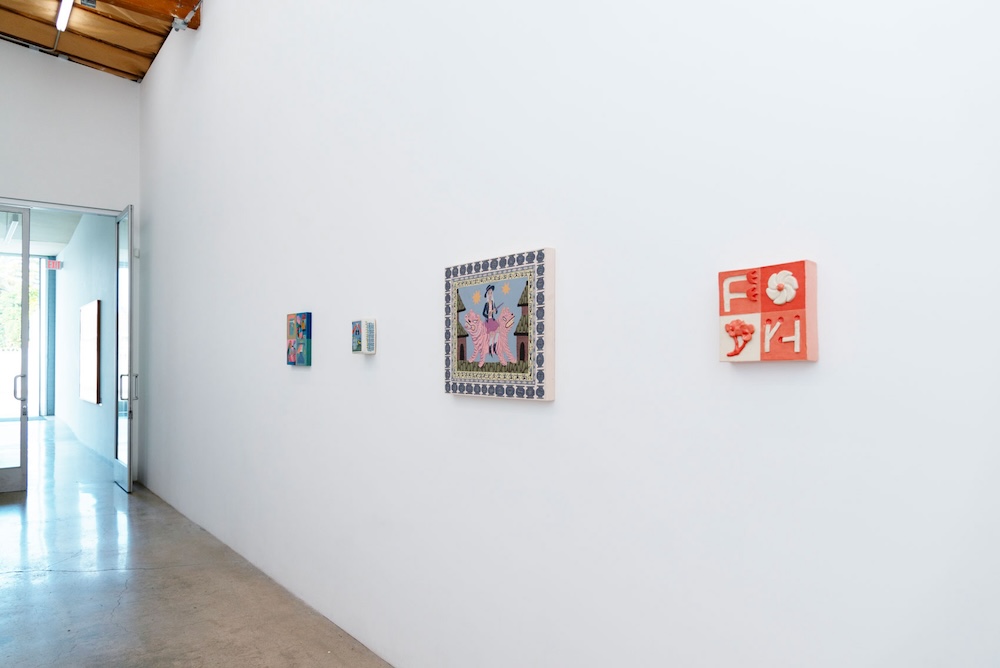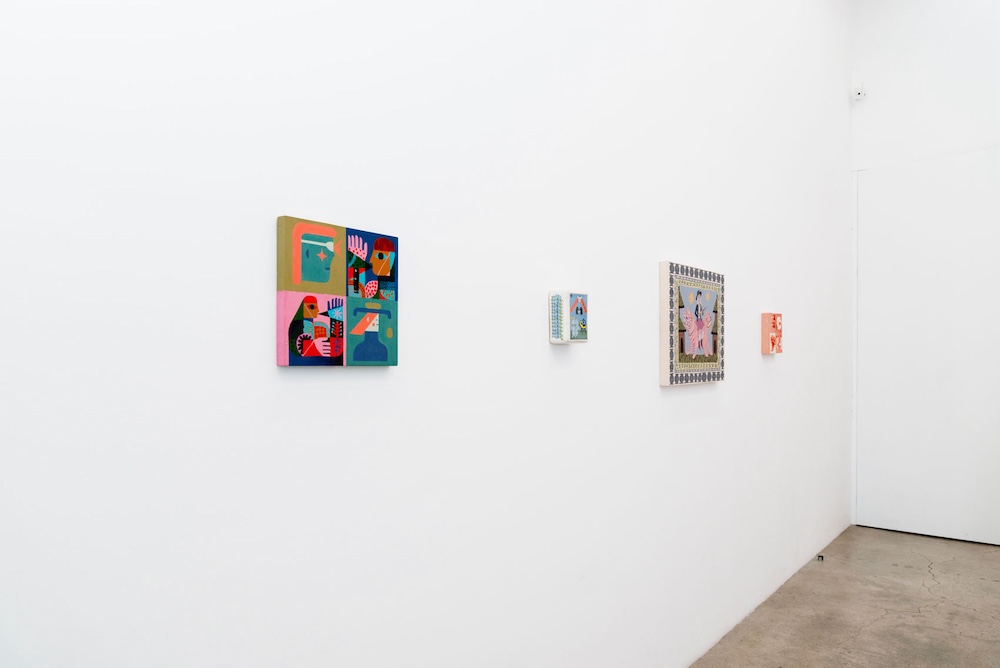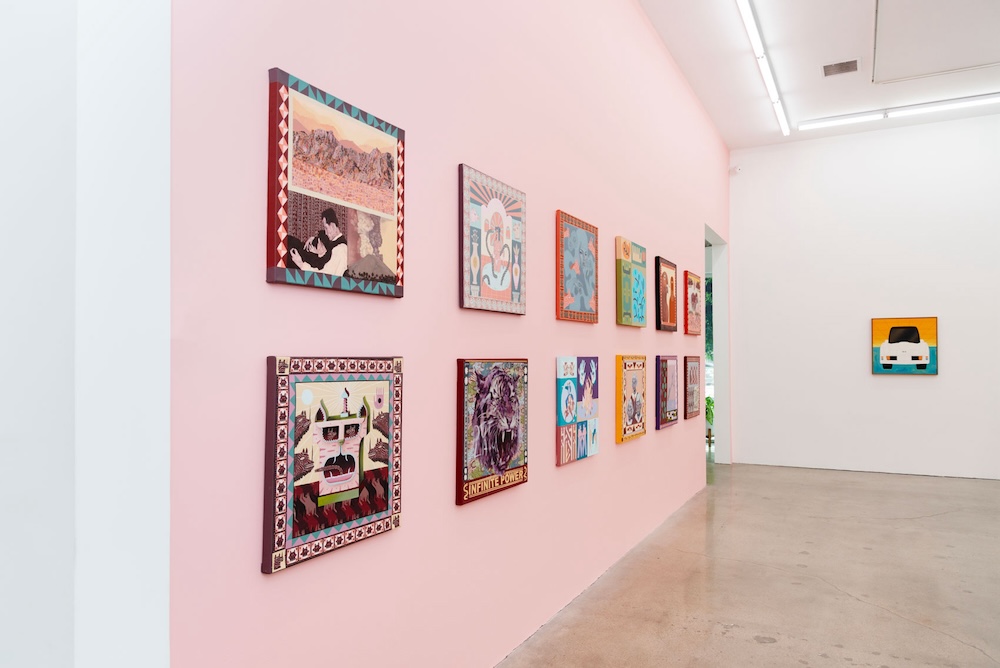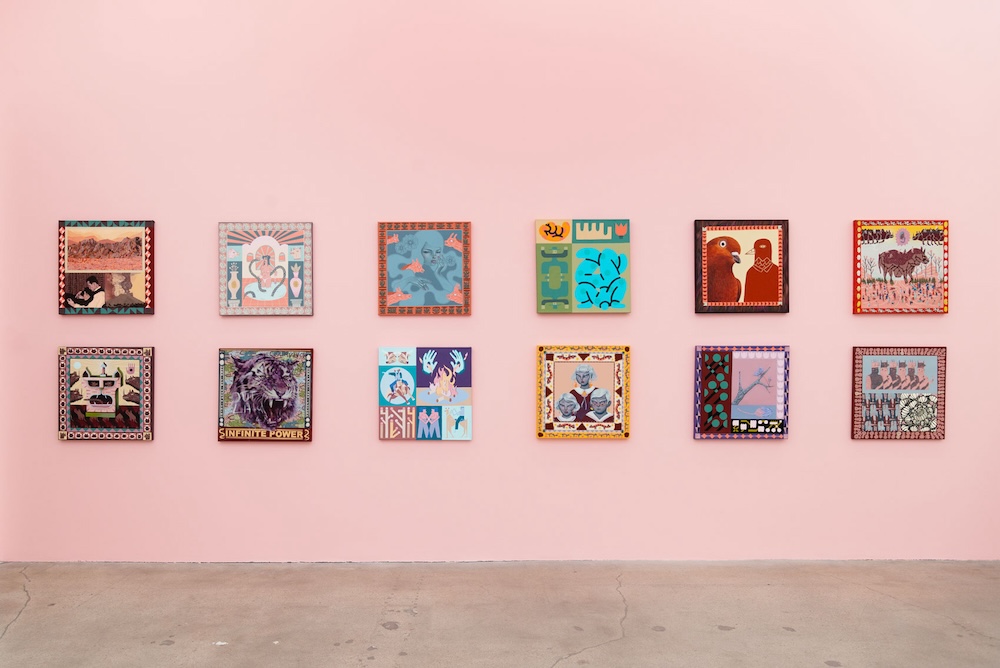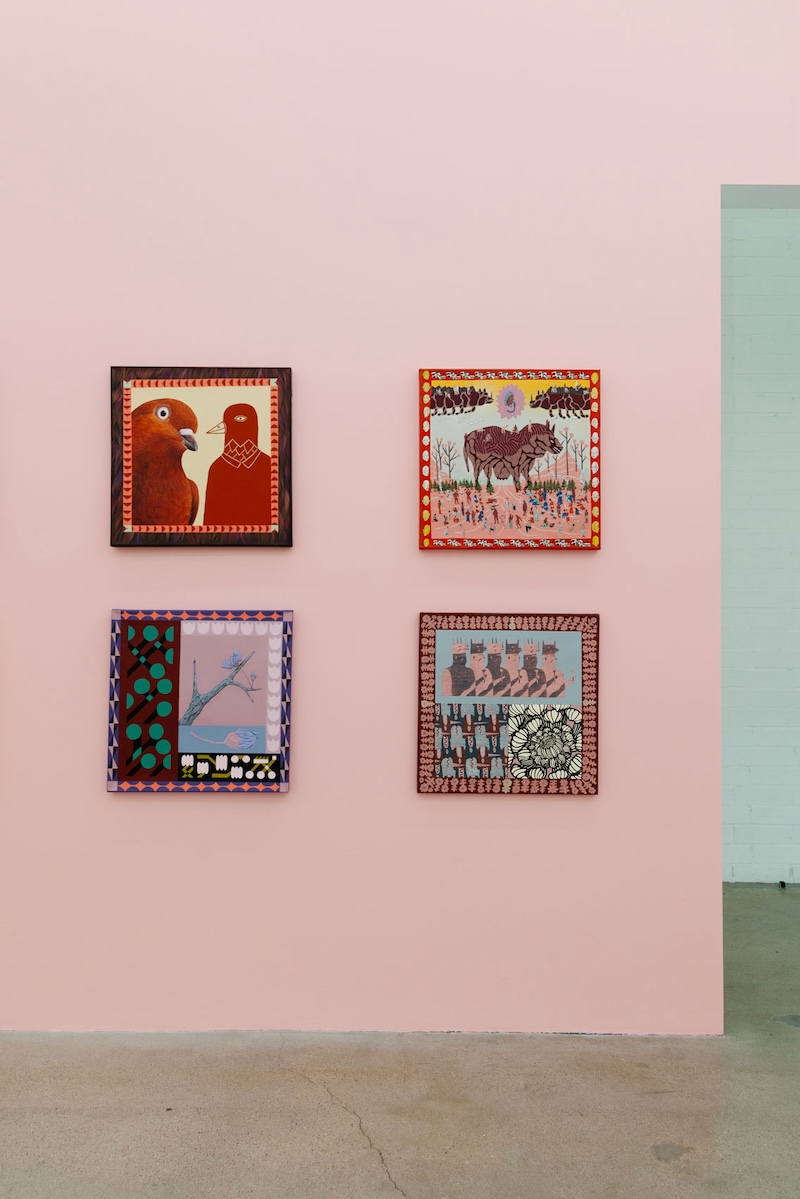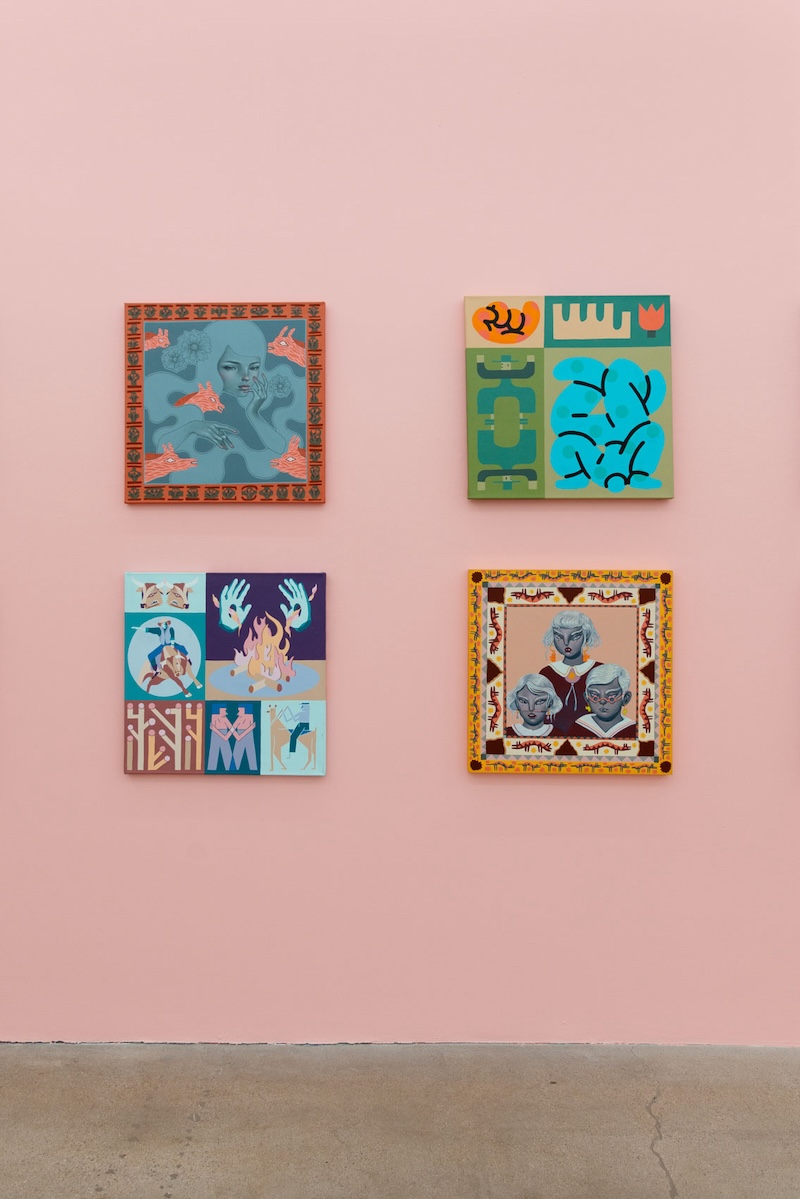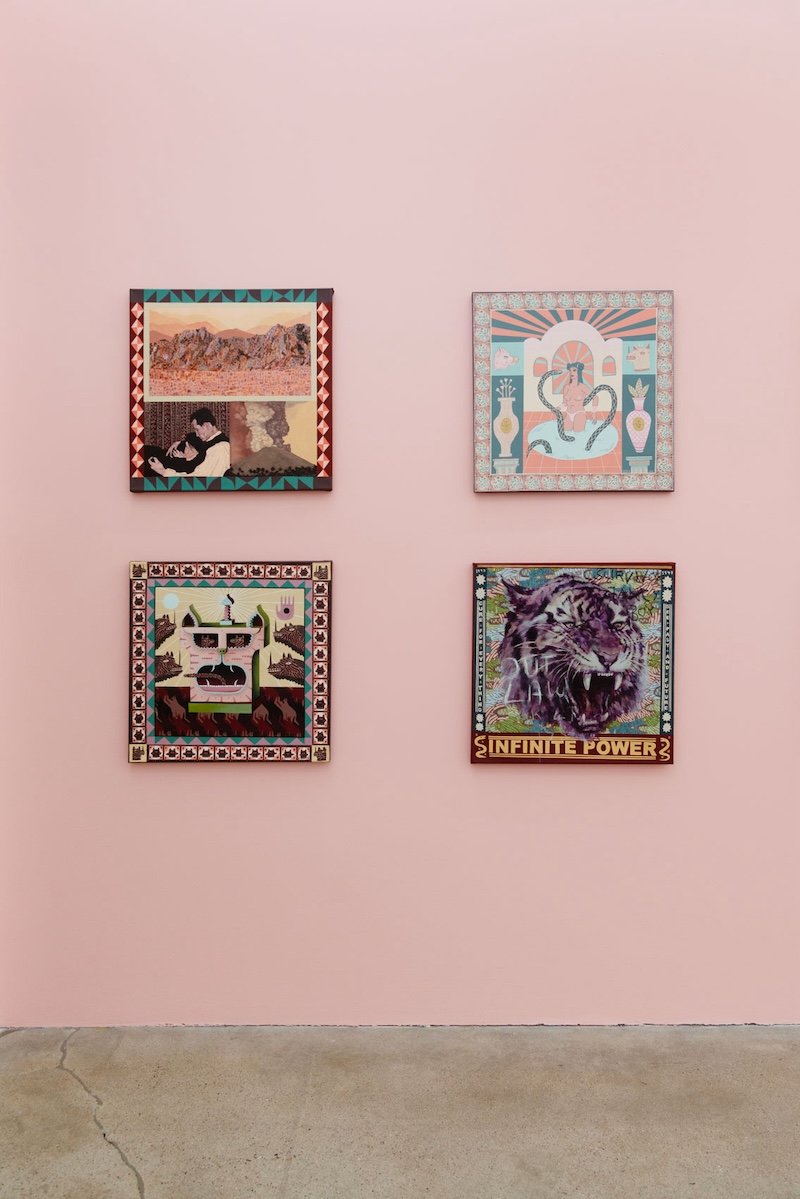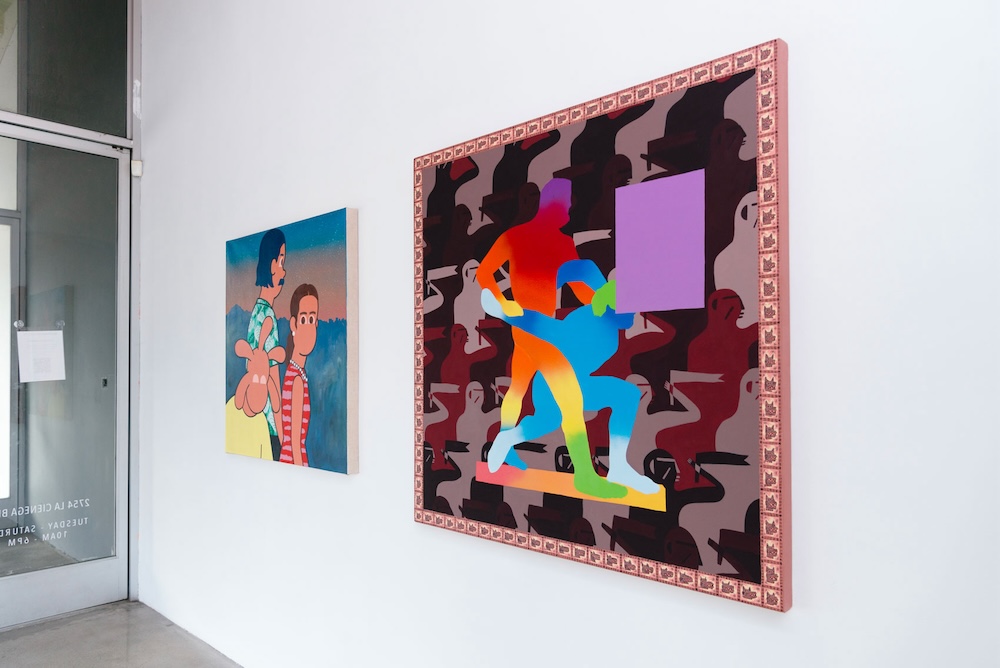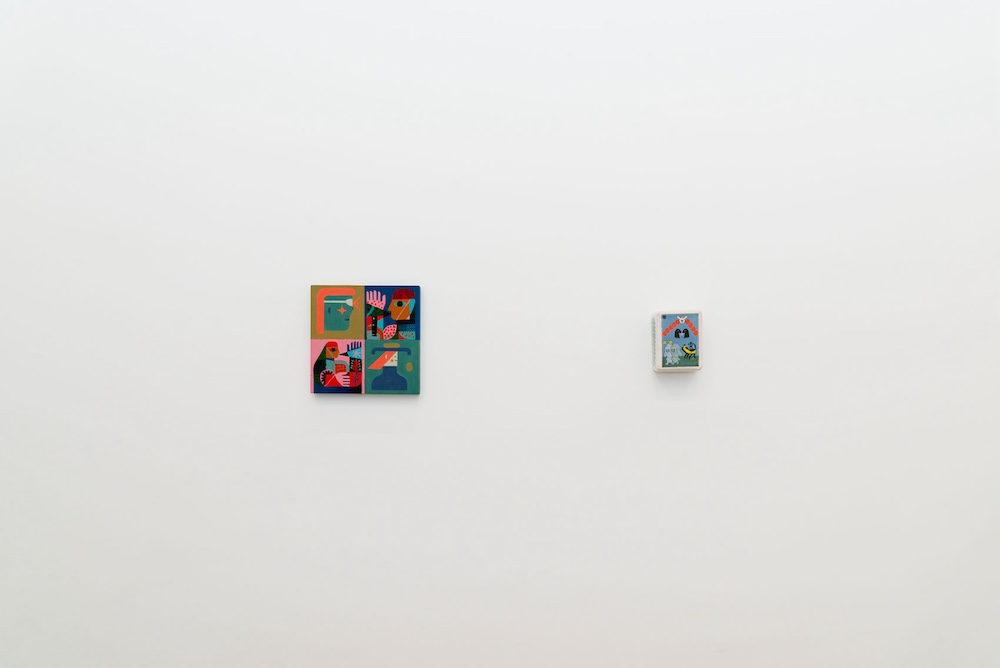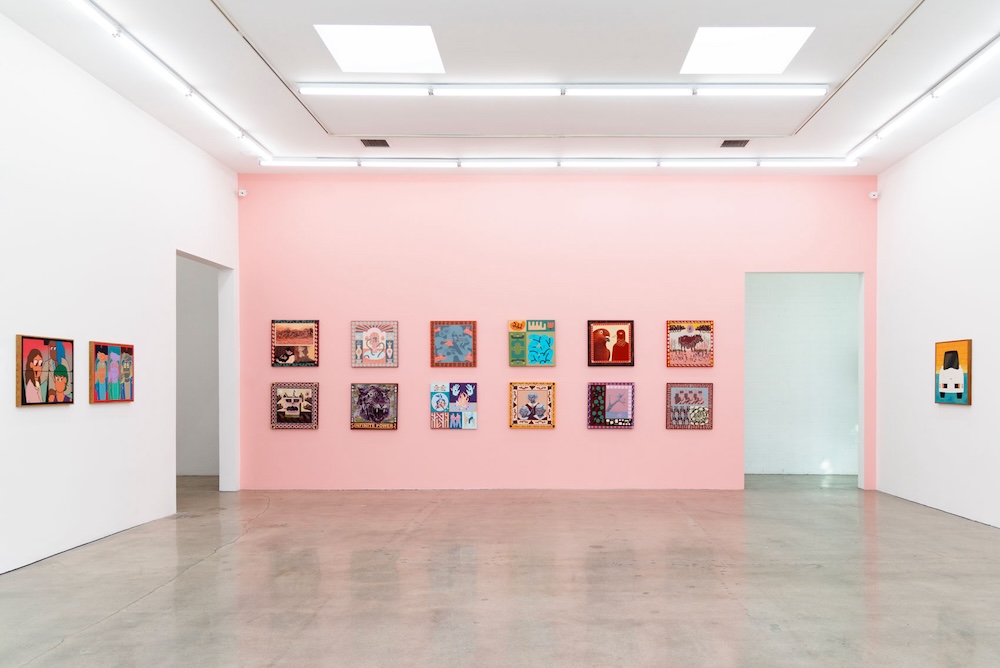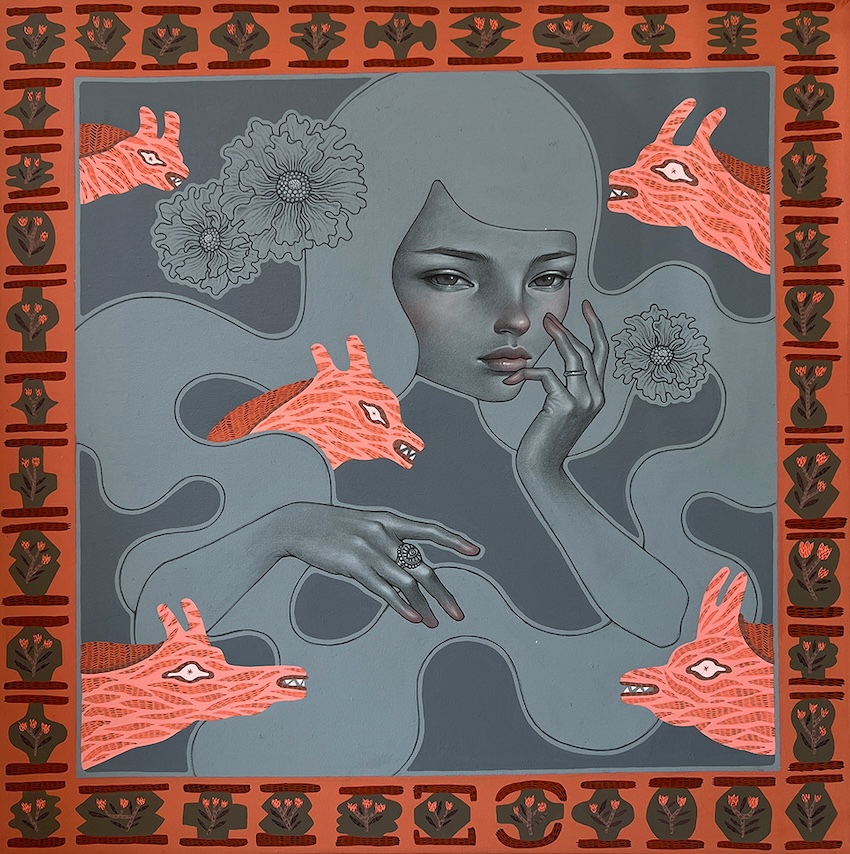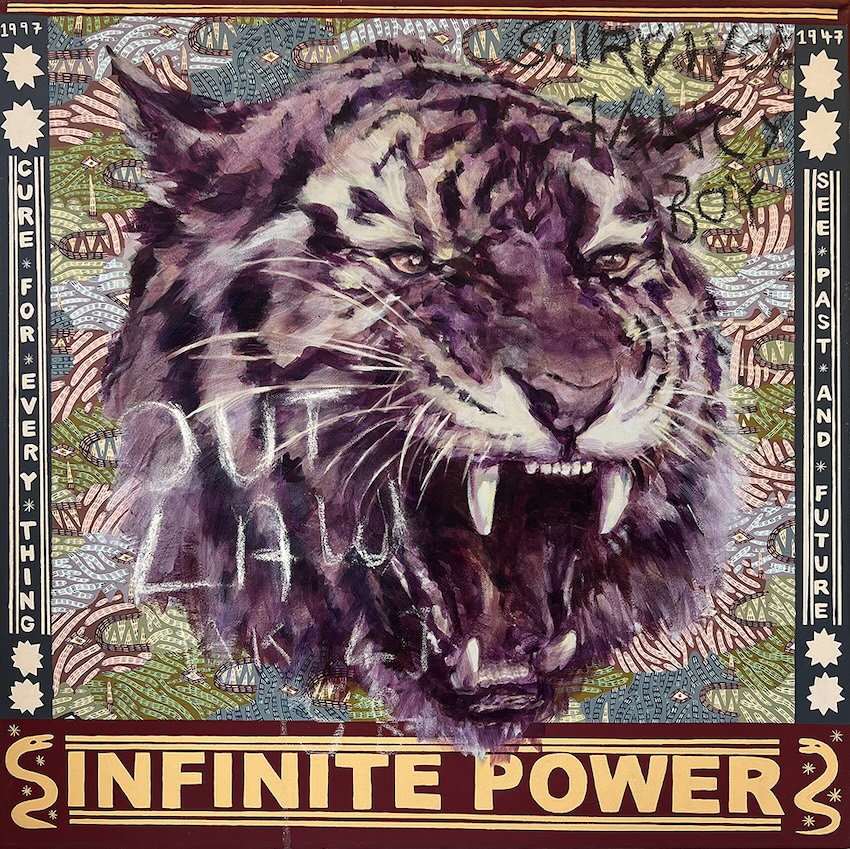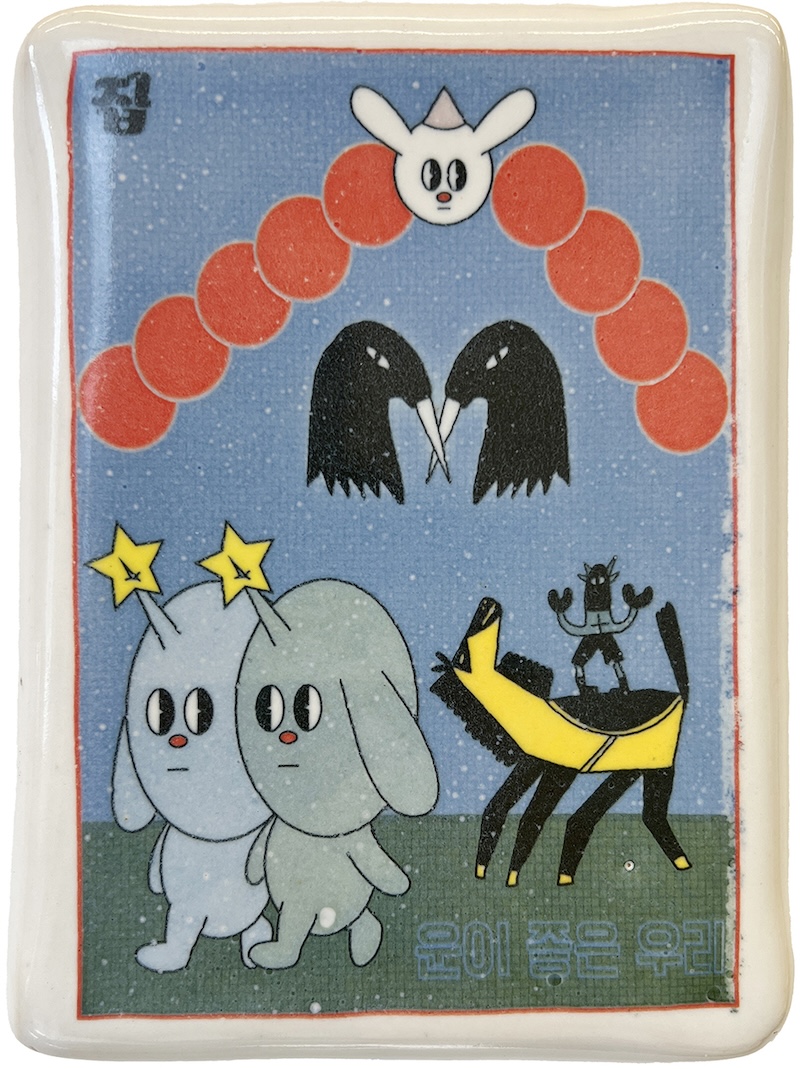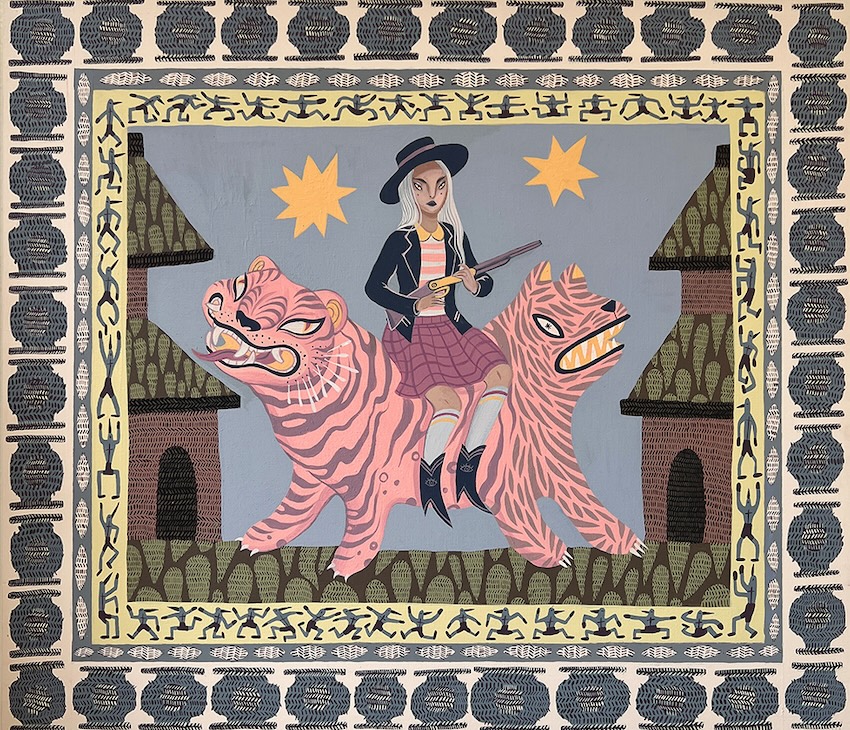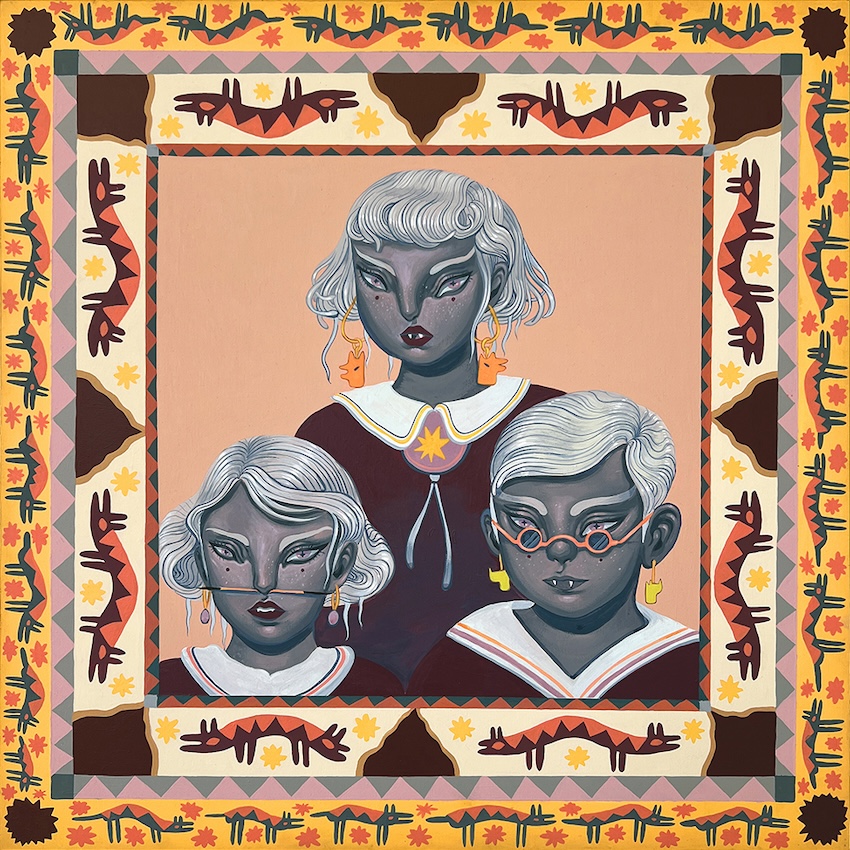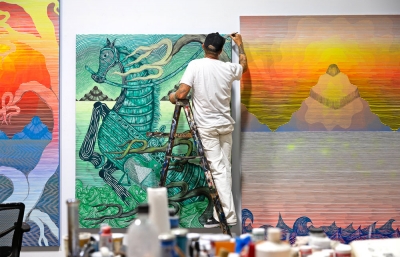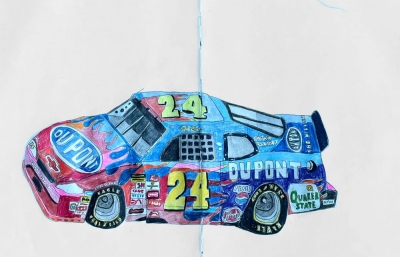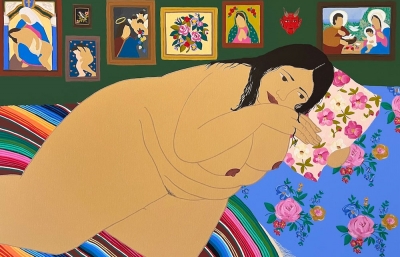Often, artists are portrayed as lone geniuses working in solitude. This is not the case for South African-born artist Keya Tama whose solo exhibition at Harman Projects, Where Our Worlds Meet, features collaborative artworks created with distinguished artists from around the globe. Spanning years of creative exploration, this exhibition offers insight into Tama’s career and community-minded approach, highlighting the rich tapestry of his artistic journey through collaboration.
Before the exhibition opened, Keya caught up with Harman Projects to discuss his collaborative process, blending personal styles, and what’s next for this young artist.
The exhibition format of Where our Worlds Meet isn’t common: you’ve authored each of the works in this exhibition with a fellow artist, calling it a “collaborative solo exhibition.” How did you start making collaborative works, and when did you decide you wanted tomake an exhibition out of all of these works?
The first collaboration, with Caratoes, was immensely enjoyable and offered a deep insight into her world as an artist and creative. This experience inspired me to expand the project. It continued to grow organically as people I admired and friends approached me, or I reached out to them. Each collaboration provided a profound insight into the minds and worlds of the artists I worked with.
All the people I collaborated with were peers and friends of mine during and many of them are friends with each other too. I found people who shared a sentimental abundance and who I feelI still truly admire.
Did any surprises arise from these works?
I was amazed by how quickly Lauren YS and Caratoes paint, with so much confidence and intuition. I really loved painting with my parents—it was my first time formally collaborating with them both and I was surprised how organically the works came together. Because I had worked on these pieces on and off for five years, the thing that surprised me the most is how attached I've become to them and how embedded they are in my mind at this point.
About your own work, you often allude to your interests in symbolism and pulling references from art history into a contemporary framework. How did you navigate staying true to your own interests and the lexicon of symbols you’ve created when making a single artwork with others?
I consider all these new works as a whole. At certain moments, I took the lead and at others I trusted my collaborators’ vision to drive the direction. I just knew that if the artwork was led by passion they would all make sense together. All the artists I worked with seemed to connect with me on ideas once we established the emotional chord we were resonating with for the piece. The rest seemed to find its path organically.
Your personal style is sort of geometric, using simple forms to create larger historical narratives. Something I think is remarkable about this show is how your style—the ways you create forms—is evident in each of the works, but completely transformed when blended or juxtaposed with the styles and techniques of others. Were there ever questions or anxieties about stylistic clashes?
I worked with Audrey [Kawasaki] on our painting to a certain point and then got stuck. It took almost five years to finally commit to a decision on how to proceed, so that was definitely a moment of anxiety. The piece became like a Mona Lisa: the longer I had it, the better it looked and the harder it was to finish my contribution.
That piece is one of my favorites in the show! I was wondering about the artistic dynamics present while creating these works. In an interview you did with Art Rapture a couple of years ago, you mentioned how you cherish the forms of artistic rivalries that exist among artist groups because they push each other to be better. Was there any of that in this collaboration process?
That wasn't especially part of the dynamic, but I think the skill sharing aspect that came really pushed me to be more experimental in many ways. In that way, I really appreciated the push.
You’ve also been a muralist for a long time, a format that often brings in multiple people to execute an artist’s vision. Did your experience as a muralist influence this body of work?
Murals definitely had a huge impact on my process along the way. I found that forms and ideas from the show that worked for both murals and canvas really strengthened my belief in the overall vision for the show; it gave me confidence as I moved forward.
There’s a mix of ceramics and paintings in this exhibition. You had been making sheep wool rugs last year as well. What prompted you to start working in these mediums, and are there other mediums you’d like to experiment with but haven’t?
I have always been inspired by multiple mediums and have found a lot of value and insight in learning histories of forms of art that have their foundations in craft. There is a deep generational passing of the skills in the craft world. I love that; I want to help honor and continue these traditions.
In the case of the tapestries, I am in love with the timeless quality they create in a room. I have been recently inspired by ceramics because my girlfriend Isolina Minjeon and I have begun to make work in that medium. I want to just keep learning a little bit about everything because I feel like when your hands understand your heart follows.
Do you approach “less” familiar mediums like ceramic and weaving differently from painting?
Making ceramics has been humbling because it takes a different kind of patience than I am used to in my painting work. That learning curve has really allowed me to feel free and play again. With tapestries, it has been inspiring to develop designs simple enough to work out during my process. And from this simplicity, I have found a new direction that's expanded into my practice as a whole.
Many of these collaborations happened in Los Angeles, but you moved there from Cape Town, South Africa, when you were 19. What was your approach to getting to know the art scene in LA?
Moving to LA was very daunting because I wasn’t studying and I didn’t know many people. I began going to art shows constantly and really found a group of people I connected to by doing that. Over time, I felt a strong connection with the city and artists who bring it to life.
Moving to New York was easy in comparison. Things have worked out organically here, but I don’t think that would be the case if I hadn’t built my career and internal compass up in LA first.
Your schedule seems to be pretty intense these days, between murals and the stream of duo-shows you’ve had with these collaborations. What’s next for you?
I have quite a few murals, a trio exhibition next year at the Straat Museum [in Amsterdam] with my parents, and some projects to be announced with Isolina. Mostly, I have been trying to work on more murals and projects that center in New York, because I have found it the best way to learn about the city and feel truly a part of it.
Where Our Worlds Meet is on view at Harman Projects in Los Angeles through August 3, 2024.

